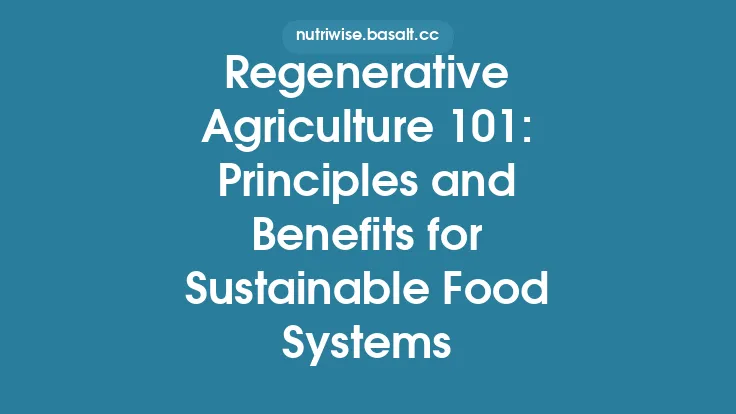The global food system is at a crossroads where ethical considerations, labor rights, and sustainability intersect with rapid technological and regulatory change. While fair‑trade principles have already reshaped many supply chains, the next decade promises a wave of innovations and policy shifts that could redefine how producers, workers, and consumers interact across continents. Anticipating these developments helps stakeholders—from smallholder farmers to multinational retailers—prepare for a more resilient, equitable, and climate‑smart food future.
Emerging Certification Frameworks and Dynamic Standards
Traditional fair‑trade certifications have relied on static criteria that are revisited only every few years. Future models are moving toward dynamic, data‑driven standards that can be updated in near real‑time.
- Modular Criteria Sets – Instead of a single monolithic standard, certification bodies are experimenting with modular modules (e.g., “soil health,” “gender equity,” “digital inclusion”) that producers can adopt incrementally. This allows farms to progress along a customized pathway rather than being forced into an all‑or‑nothing model.
- Performance‑Based Scoring – New frameworks will incorporate quantitative performance metrics (e.g., pesticide reduction percentages, carbon sequestration rates) alongside qualitative assessments. Scores can be publicly displayed on product packaging or digital platforms, giving consumers a nuanced view of a product’s ethical footprint.
- Cross‑Certification Compatibility – To reduce duplication of effort, emerging standards are being designed to align with existing schemes such as organic, regenerative agriculture, and climate‑smart agriculture certifications. This “interoperability” reduces audit fatigue for producers and creates a more coherent label ecosystem.
Digital Traceability and Blockchain Integration
Traceability has long been a cornerstone of ethical sourcing, but the next generation of digital tools promises immutable, end‑to‑end visibility that goes beyond simple batch tracking.
- Blockchain‑Based Ledger Systems – By recording every transaction—from seed purchase to final retail—on a distributed ledger, stakeholders can verify that labor standards were upheld at each step. Smart contracts can automatically release premium payments when predefined labor‑rights criteria are met, ensuring timely compensation for workers.
- IoT Sensors for Labor Conditions – Wearable devices and environmental sensors can capture data on working hours, temperature exposure, and safety incidents. When integrated with blockchain, this data becomes tamper‑proof evidence that can trigger compliance alerts or trigger corrective actions.
- Consumer‑Facing QR Codes – Scanning a QR code on a product could reveal a concise “labor rights dashboard” showing metrics such as average wages paid, gender parity ratios, and safety compliance scores. This level of transparency empowers shoppers to make informed choices without requiring deep research.
AI‑Driven Risk Assessment and Early Warning Systems
Artificial intelligence is poised to become a proactive tool for safeguarding labor rights across sprawling, fragmented supply chains.
- Predictive Analytics for Labor Violations – Machine‑learning models can ingest satellite imagery, weather data, market price fluctuations, and social media sentiment to predict where labor abuses are most likely to arise (e.g., during sudden price drops that pressure growers to cut costs). Early warnings enable NGOs, auditors, and companies to intervene before violations become systemic.
- Natural Language Processing for Complaint Monitoring – AI can scan local news outlets, labor union forums, and worker messaging apps in multiple languages to detect emerging grievances. Automated sentiment analysis helps organizations prioritize investigations and allocate resources efficiently.
- Dynamic Allocation of Auditing Resources – By continuously updating risk scores, AI can guide auditors to high‑risk farms, reducing the need for blanket, costly inspections while maintaining rigorous oversight.
Financing Mechanisms Aligned with Labor Rights
Access to capital remains a critical barrier for smallholder producers seeking to meet higher labor standards. Future financing models are increasingly tying credit terms to ethical performance.
- Impact‑Linked Loans – Financial institutions are piloting loans where interest rates decrease as farms achieve specific labor‑rights milestones (e.g., certification of safe working conditions, documented gender‑balanced hiring). This creates a direct financial incentive for continuous improvement.
- Green‑Labor Bonds – Emerging bond instruments combine environmental and social criteria, allowing investors to fund projects that simultaneously reduce carbon footprints and enhance worker welfare. Proceeds may be earmarked for building safe storage facilities, providing protective equipment, or establishing on‑farm health clinics.
- Crowdfunded Ethical Pools – Digital platforms enable consumers and ethical investors to pool resources that are disbursed to cooperatives meeting transparent labor benchmarks. Real‑time reporting via blockchain ensures that funds are used as intended, fostering trust and repeat participation.
Policy Evolution at International and National Levels
Regulatory landscapes are shifting to embed labor rights more firmly within trade and agricultural policies.
- Inclusion of Labor Clauses in Trade Agreements – New bilateral and multilateral trade accords are beginning to incorporate enforceable labor‑rights provisions, with mechanisms for dispute resolution and penalties for non‑compliance. This raises the baseline expectations for all exporters, not just those seeking premium markets.
- National Minimum Standards for Ethical Sourcing – Several governments are drafting legislation that mandates a minimum set of labor standards for any product bearing a “fair‑trade” label sold domestically. Such laws create a level playing field and reduce the risk of “greenwashing.”
- Global Monitoring Bodies – Proposals for an International Labor‑Rights Observatory aim to aggregate data from certification schemes, NGOs, and governmental audits, providing a unified dashboard for policymakers and the public.
Integration with Regenerative and Climate‑Smart Agriculture
Labor rights cannot be isolated from broader sustainability goals. The convergence of fair‑trade principles with regenerative practices is shaping a new paradigm.
- Co‑Benefit Metrics – Certification bodies are developing metrics that capture both soil health improvements and labor outcomes, such as the number of workers trained in regenerative techniques or the reduction in pesticide‑related health incidents.
- Carbon Credit Allocation to Labor‑Improving Practices – Projects that combine carbon sequestration with enhanced worker safety (e.g., agroforestry systems that reduce exposure to harmful chemicals) may qualify for higher carbon credit values, providing additional revenue streams for farms.
- Resilience Planning – Climate‑adaptation plans now often include labor‑rights components, ensuring that workers are protected during extreme weather events (e.g., guaranteed paid leave during floods) and that recovery efforts prioritize fair wages.
Consumer Behavior Shifts and the Rise of “Ethical Experiential” Purchasing
Future demand is being driven not just by price or taste, but by immersive, values‑based experiences.
- Story‑Driven Packaging – Brands are moving toward packaging that tells a concise, data‑backed story of the workers behind the product, using QR‑linked narratives, short videos, and interactive timelines.
- Subscription Models with Ethical Transparency – Meal‑kit and grocery subscription services are offering “ethical tiers” where subscribers receive regular updates on labor‑rights progress, allowing them to track the impact of their purchases over time.
- Gamified Ethical Engagement – Mobile apps are introducing gamification elements (e.g., earning badges for purchasing products that meet certain labor standards) to encourage repeat ethical buying and to build community around shared values.
Regional Innovations and Context‑Specific Solutions
Different geographies present unique challenges and opportunities for advancing labor rights within fair‑trade frameworks.
- Sub‑Saharan Africa: Mobile‑First Auditing – With limited internet infrastructure, auditors are leveraging USSD‑based reporting tools that allow field agents to submit compliance data via basic mobile phones, ensuring coverage even in remote areas.
- Southeast Asia: Community‑Managed Data Hubs – Farmer cooperatives are establishing locally governed data repositories that store labor‑rights records, enabling collective bargaining and transparent negotiation with buyers.
- Latin America: Indigenous Labor Rights Integration – New certification modules are being co‑designed with Indigenous groups to embed cultural labor practices (e.g., communal decision‑making) into the broader fair‑trade criteria, respecting both human rights and traditional knowledge.
Challenges and Mitigation Strategies
While the outlook is promising, several hurdles must be addressed to realize these future trends.
- Data Privacy Concerns – Collecting granular labor data raises privacy issues. Implementing robust anonymization protocols and obtaining informed consent are essential to protect workers.
- Technology Access Gaps – Smallholders may lack the hardware or connectivity needed for IoT or blockchain solutions. Public‑private partnerships that subsidize equipment and provide training can bridge this divide.
- Standardization Fatigue – The proliferation of modular standards risks overwhelming producers. Harmonization initiatives led by international bodies can streamline criteria and reduce duplication.
- Verification Integrity – As digital tools become more sophisticated, so do attempts at manipulation. Continuous third‑party oversight, combined with open‑source audit algorithms, can safeguard system integrity.
Looking Ahead: A Vision for 2035
By the mid‑2030s, the convergence of adaptive certification models, blockchain‑anchored traceability, AI‑driven risk monitoring, and labor‑linked financing is expected to create a self‑reinforcing ecosystem where ethical labor practices are not an add‑on but a core component of market competitiveness. In this future:
- Producers will receive real‑time feedback on labor‑rights performance, enabling rapid corrective action.
- Consumers will enjoy transparent, data‑rich product experiences that connect taste to tangible social impact.
- Policymakers will have access to unified, cross‑border labor‑rights dashboards that inform evidence‑based regulation.
- Investors will allocate capital to projects that demonstrably improve both worker welfare and environmental outcomes, accelerating the transition to a truly sustainable food system.
The trajectory is clear: fair‑trade and labor rights are moving from static certification checkpoints to dynamic, technology‑enabled pillars of global food governance. Stakeholders who embrace these emerging trends will not only safeguard the dignity of food workers but also unlock new market opportunities, foster climate resilience, and build a more equitable food future for all.





